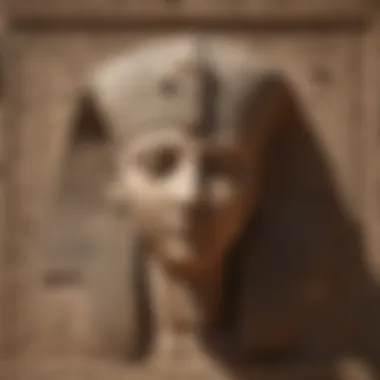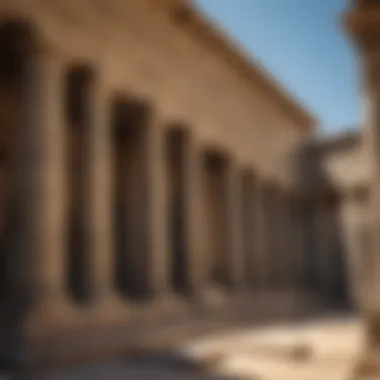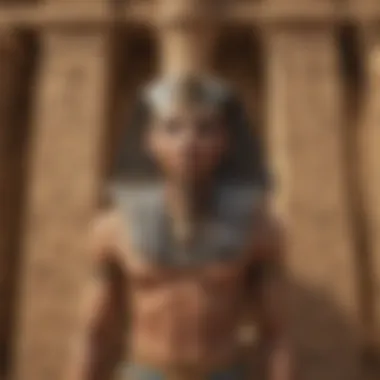Exploring the Dendera Light: Ancient Technology or Myth?


Intro
The Dendera Light remains a subject of intrigue among scholars, historians, and those interested in ancient technologies. Found within the Hathor Temple in Dendera, Egypt, the reliefs illustrate what some interpret as potential forms of illumination used by the ancient Egyptians. In exploring these reliefs, we delve not only into their visual depictions but also the underlying historical and cultural contexts that shape our understanding.
Research Highlights
Overview of Key Findings
The investigation into the Dendera Light reveals several key findings:
- Symbolic Representation: The reliefs are not merely decorative; they may hold significant spiritual and symbolic meaning tied to ancient Egyptian beliefs.
- Technological Interpretation: Some hypotheses suggest that these depictions indicate a sophisticated understanding of light and electricity, potentially far ahead of their time.
- Cultural Context: The artifacts originate from a period rich in symbolism and myth, which complicates straightforward interpretations. The overlap of art, religion, and technology in ancient Egypt is a primary focus.
Significance of the Research
Understanding the Dendera Light is crucial for multiple reasons:
- Cultural Insight: It offers glimpses into ancient Egyptian practices and beliefs surrounding light, deities, and the cosmos.
- Technological Implications: Exploring claims of ancient technology invites comparisons with modern advancements and posits questions about historical innovation.
- Interdisciplinary Relevance: This topic is not confined to archaeology. It touches on history, art, physics, and religious studies, making it a valuable resource across disciplines.
"The Dendera Light serves as a reminder of the complexities inherent in interpreting ancient artifacts. Acknowledging the multifaceted nature of these reliefs enriches our understanding of the people who created them."
Original Research Articles
Summary of the Article
Research articles discussing the Dendera Light often focus on the interpretations of the reliefs, examining both archaeological evidence and textual references. These studies contribute to a broader discourse on ancient Egyptian civilization and its technological capabilities.
Author Contributions
Various scholars have made notable contributions to this field. They analyze the reliefs through different lenses, providing valuable insights that help decode the meanings encapsulated within these ancient artworks. Each contribution enhances our collective comprehension of the Dendera Light and its implications.
Thus, as we further explore this enigmatic subject, we aim to uncover the layers of meaning and significance tied to the Dendera Light, highlighting its importance in understanding the rich tapestry of ancient Egyptian culture.
Historical Context of the Dendera Temple
Understanding the historical context of the Dendera Temple is pivotal in grasping the significance of the Dendera Light. The temple, dedicated to the goddess Hathor, dates back to the Greco-Roman period in Egypt, primarily constructed during the reign of Ptolemy VI. It not only serves as a religious sanctuary but also represents the architectural and artistic brilliance of ancient Egyptian civilization.
The construction and architecture of the Dendera Temple reflect advanced engineering techniques and aesthetic sensibilities. The temple is famed for its intricate reliefs, which may hold clues to the technological capabilities of the era. The site encompasses a vast complex featuring a hypostyle hall, sanctuaries, and a birth house, known as the Mammisi, dedicated to Hathor’s cult. This architectural layout demonstrates the importance of religious practices intertwined with daily life in ancient Egypt. The precision of the carvings and the alignment of structures with celestial bodies suggest a sophisticated understanding of geometry and astronomy. The enduring nature of these elements hints at a society that placed great emphasis on both the spiritual and the physical aspects of their existence.
The religious significance of the temple is profound. It served as a center for worship and rituals dedicated to Hathor, the goddess of music, dance, and fertility. The belief in her protective powers resonates through the inscriptions and depictions found throughout the temple. These reliefs are essential for understanding the spiritual landscape of ancient Egyptians, illustrating how they sought divine intervention in their lives through rituals and offerings. Understanding these aspects sheds light on the intersection between mythology and everyday life, revealing how belief systems informed the culture and society.
Finally, the cultural impact on ancient Egypt is also noteworthy. The temple complex was not just a site for religious observance but acted as a hub for community gatherings and cultural expression. It reflects the central role of sacred spaces in ancient society, influencing social norms, artistic expression, and the cohesion of the community. Throughout history, the temple has endured as a symbol of ancient Egyptian civilization, captivating scholars and enthusiasts alike.
"Dendera’s temple complex exemplifies the architectural splendor and religious fervor of ancient Egyptian culture, showing how spirituality and artistry unite in this remarkable historical site."
In essence, the Dendera Temple stands as an important testament to the interplay of religion, architecture, and culture in ancient Egypt. Its historical context not only aids in the understanding of the Dendera Light but also frames a broader narrative of the civilization’s lasting legacy.
Description of the Dendera Light Reliefs
The Dendera Light reliefs are widely regarded as a significant element in discussions surrounding ancient Egyptian technology. These carvings, located in the Temple of Hathor at Dendera, have drawn various interpretations over the years. Notably, they are said to depict strange devices, which some argue could represent a form of ancient illumination or technology. Understanding the visual and contextual aspects of these reliefs is crucial for further discussions on their potential meanings.


The importance of these reliefs lies in their intriguing visual language and the mysteries they encapsulate. Some researchers assert that the imagery could suggest sophisticated technological knowledge in ancient Egypt, while skeptics argue that these interpretations are overly speculative. A comprehensive examination provides insight into both the cultural context of these artifacts and their implications in modern interpretations of historical technology.
Visual Analysis of the Reliefs
The reliefs themselves are intricately detailed and exhibit a variety of symbols and figures. They are believed to show a peculiar object, often interpreted as a type of bulb or light source, alongside other figures engaging with it. The positioning and expression of these figures contribute substantially to the dialogue about their purpose.
The way the light source appears to interact with individuals in the reliefs raises questions about illumination practices in ancient Egypt. Scholars examine elements such as:
- The overall arrangement of figures.
- Specific symbols adjacent to the light source.
- Artistic techniques that captivate the viewer’s attention.
One key detail comes from the interpretation of the object’s form. It features a distinctly rounded aspect, which aligns with descriptions of bulbs from other cultures. Consequently, this resemblance leads some to argue that it represents advanced electrical engineering, a notion that faces scrutiny.
Comparison with Other Ancient Artifacts
When placed alongside other ancient artifacts, the Dendera Light reliefs raise several fascinating comparisons. For example, the reliefs share similarities with certain inscriptions and objects found in other Egyptian temples, such as the Temple of Karnak. Both locations exhibit a preoccupation with illumination, albeit represented through different cultural elements.
Moreover, looking beyond Egypt, parallels can be drawn with Mesoamerican and Mesopotamian artifacts that also depict potential light sources. This comparison extends our understanding of how diverse cultures approached the concept of light and technology.
While direct evidence linking the Dendera Light reliefs to advanced technology may be scant, their existence within the broader ancient narrative of illumination warrants exploration. Such investigations provide context to ancient beliefs about light, creation, and the divine, further enriching the significance of the Dendera Light in both ancient and modern discussions.
Interpretations of the Dendera Light
The Dendera Light has sparked a plethora of discussions surrounding its meaning and significance. Its interpretations play a crucial role in understanding ancient Egyptian civilization. The imagery found in the Dendera temple offers visual clues that have intrigued historians, archaeologists, and enthusiasts alike. It questions whether these depictions are manifestations of advanced ancient technology or merely religious symbolism. Each perspective yields insights into how ancient Egyptians viewed light and its associated power and divinity. Exploring interpretations enables a fuller appreciation of the cultural and technological context of the time.
Mainstream Archaeological Views
Mainstream archaeology primarily interprets the Dendera reliefs as iconographic representations tied to the religious beliefs of the ancient Egyptians.
Most scholars assert that the depicted figures are significant within the framework of Egyptian mythology. They contend that these reliefs symbolize the relationship between the divine and the earthly realms, specifically associated with the goddess Hathor, who represents fertility, motherhood, and joy. Archaeologists emphasize that the so-called Dendera Light does not depict knowledge of electricity or advanced technology. Instead, they view it as a creative expression demonstrating the Egyptians' understanding of light in relation to their gods.
In terms of art, the reliefs follow established conventions found throughout Egyptian art, adhering to the symbolic code of thumb is closer to the meaning. This canon emphasized clarity, stability, and continuity in design, aiming to enhance the message communicated through the images. Thus, the focus remains on the spiritual and cultural narratives, rather than technological innovation.
Alternative Theories
Alternative theories regarding the Dendera Light propose more radical interpretations of the reliefs. Some researchers suggest that these depictions show advanced technologies that surpass what is traditionally recognized. Proponents of this view argue that the imagery resembles modern electric light sources. This interpretation often draws comparisons to contemporary notions of illumination.
Such ideas have gained traction through popular media and fringe theories. They suggest that the ancient Egyptians may have harnessed electricity or used some form of illumination technology far beyond that of their contemporaries. Some individuals even cite parallels with the modern concept of a light bulb, claiming that these ancient designs imply knowledge of electrical energy.
Many theorists who support these views often disregard traditional archaeological insights, proposing that ancient civilizations possessed lost technologies. This perspective raises questions about the limits of historical understanding and brings into focus the vast range of human ingenuity—or perhaps lost knowledge possible in ancient times.
"These interpretations reveal a striking divergence in how the Dendera Light is perceived, leading to broader discussions about ancient technology and its implications for our understanding of history."
The debates surrounding the Dendera Light highlight the complexities of reconciling historical narratives with evolving interpretations. As research continues, the discourse shifts between established archaeology and alternative perspectives, reflecting on our inherent quest to comprehend the past.
Scientific Examination of the Dendera Light Hypothesis
The exploration of the Dendera Light hypothesis holds significant relevance in understanding the intersection of ancient technology and mythology. This section delves into various aspects related to the scientific analysis of the Dendera Light, elucidating the critical elements that shape our perceptions of ancient Egyptian achievements. The ability to investigate these reliefs with modern technologies enables researchers to sift through the intricate layers of history. Through this examination, we can assess the authenticity and implications of ancient artifacts that may challenge conventional thoughts on technological capabilities of historical civilizations.
Technological Anachronisms?
The notion of technological anachronisms refers to artifacts or depictions that suggest a level of innovation not typically associated with the time in which they emerged. The Dendera Light reliefs present a unique case study as they appear to depict advanced illumination techniques. Researchers question whether these representations indicate a form of ancient technology similar to contemporary light sources.


Some interpretations suggest that the reliefs portray electrical devices, as seen in the peculiar carvings resembling light bulbs or the spiraled shapes interpreted as filaments. Critics, however, point to the absence of supporting evidence from the archaeological record that could affirm these claims. It's essential to evaluate these claims through a rigorous lens of archaeological standards to determine their validity.
Material Analysis of Artifacts
Material analysis forms a cornerstone of understanding the context of the Dendera Light. Examination of the composition of the materials used in the reliefs can unveil insights into the tools and technologies available to the ancient Egyptians. Such an analysis may offer information about the methods of carving and the durability of the materials, indicating a level of craftsmanship.
Additionally, connecting the materials to their geographical sources can help clarify trade routes and resource distribution in ancient Egypt. By understanding the properties of these materials, researchers can foster a more precise understanding of the technological prowess of ancient artisans. This investigation aids in demystifying whether the alleged lighting methods were plausible and feasible.
Illumination Methods in Ancient Egypt
Understanding illumination methods in ancient Egypt involves exploring various sources used to create light for functional and ceremonial purposes. While oil lamps made of clay or bronze were prevalent, other methods may not be as well-documented. The possibility of using large torches or reflecting sunlight through polished surfaces was common in temples.
An analysis of the Dendera Temple layouts also draws attention to architectural features intended for maximizing natural light. Investigating how light played a role in religious practices and daily life sheds light on the social and cultural drivers behind the use of illumination.
"Exploring the nuances in ancient Egyptian light sources can reveal the intersections between religion, technology, and daily activities that defined a civilization."
In summary, the scientific examination of the Dendera Light hypothesis presents rich areas for study, particularly concerning technological anachronisms, material composition, and illumination practices. These elements create a multifaceted understanding of how ancient Egyptians might have perceived and utilized light, transcending myths while opening doors to modern-day implications for historical technology.
Theological and Philosophical Implications
The study of the Dendera Light transcends mere historical analysis; it invites profound theological and philosophical inquiry. Understanding the implications of such interpretations offers a glimpse into the ancient Egyptian mindset regarding light, divinity, and existence. The reliefs found at Dendera do not only depict possible technological advancements; they symbolize a deeper connection between the divine and illumination.
The relationship between gods and light in Ancient Egypt is crucial to grasping how they viewed the universe. The Egyptians often associated light with creation, purity, and divinity. They believed that light came from the gods themselves, acting as a guiding force in life. Exploring this aspect enhances our comprehension of not just the artifacts but also the cultural and religious frameworks that governed ancient society.
Gods and Light in Ancient Egyptian Beliefs
In Egyptian mythology, light is intrinsically linked to several deities, primarily Ra, the sun god. Ra's daily journey across the sky symbolizes life-giving energy and the cyclical nature of existence. As Ra emerges from the darkness of night, the appearance of light signifies rebirth and renewal.
Much of the religious practice revolved around ensuring that the light from the gods was present in their lives. Temples were designed to maximize sunlight, with strategic openings allowing rays to illuminate sacred spaces during specific times of the year. This external reflection of divine light manifests the belief that there is a continuous flow between the earthly realm and the sacred.
- Ra is often depicted as a hawk with a sun disk atop his head.
- Ancient Egyptians believed in a cosmic battle between light and darkness, underscoring the importance of maintaining balance.
The interpretation of the Dendera Light reliefs can thus be seen as a visual manifestation of these beliefs. They may represent the divine presence, an attempt to illustrate the very essence of life and purity through light. By scrutinizing these elements, we gain deeper insight into the spiritual underpinnings of Egyptian culture.
Symbolism of Light in Religion
Symbolically, light serves various functions across many religions, but in ancient Egyptian belief, it was more than just a representation of goodness. Light symbolized knowledge and enlightenment as well. The Egyptians perceived knowledge as a source of power, much like the sun itself. In many ancient texts, light is frequently mentioned as a guiding force leading individuals toward truth and wisdom.
This duality of light as both divine energy and a metaphorical representation of knowledge provides rich ground for discussions regarding the nature of existence. Are the reliefs, then, an invitation to explore the interface of science and spirituality? Can light be perceived as the bridge between the material and the metaphysical?
"Light is the first of the created things. Only with light can creation happen; without it, all is void."
The study of the Dendera Light fosters broader discussions about how ancient civilizations interpreted their environment and the cosmos. As students, researchers, and practitioners engage with these themes, we realize that understanding ancient symbols requires not only contextual knowledge of artifacts but also an appreciation for the universal human quest for meaning. In this way, the inquiry into the Dendera Light shifts from mere speculation to a discourse on humanity's place in the universe.
Modern Reactions and Cultural Impact
The Dendera Light, often enveloped in mystery, has sparked considerable interest in both the academic realm and the general public. The reactions to this topic illustrate the significance of ancient artifacts in modern culture. The fascination reflects not only curiosity about historical technologies but also how these symbols can influence contemporary understanding of ancient civilizations.
Public Interest and Media Representation


The modern public's attention towards the Dendera Light initiates from various sources, including documentaries, social media forums, and academic discussions. Television programs exploring ancient mysteries frequently feature the Dendera Light, presenting it as a potential indication of advanced ancient knowledge.
Social media platforms like Reddit often serve as forums for discussions, allowing enthusiasts to share interpretations and theories. This interactive element enables a broader audience to engage with archaeological finds, pushing the boundaries of traditional scholarly discourse.
Media representation varies, from serious documentary styles to sensational coverage that leans towards conspiracy theories. Such representations can skew public perception, leading to a conflation of fact and speculation. The focus often shifts to sensationalist narratives that highlight ancient alien theories rather than objective archaeological evidence. This creates a complex environment for those seeking authentic information about the Dendera Light.
Influence on Popular Culture
The Dendera Light has permeated various facets of popular culture, influencing literature, films, and visual art. In literature, authors have often referenced ancient technologies and their implications for human history, with the Dendera Light serving as a key example. Movies that delve into the ancient world frequently draw upon themes related to advanced civilizations, and the Dendera Light stands as a testament to this enduring fascination.
Visual artists utilize the iconography of the Dendera Light, sometimes integrating it into contemporary works that challenge perceptions of light, power, and divinity. The blending of historical symbolism with modern interpretation opens discussion about our continuous quest for knowledge and technological advancement.
"The Dendera Light serves not just as a subject of academic inquiry but as a cultural artifact that resonates with the quest for understanding our past."
This cultural resonance underscores the impact of the Dendera Light on how we view ancient Egyptian civilization. Its representations in modern media stimulate ongoing debate about not only what was possible in the past but also how events and artifacts from history shape our narratives today.
Ongoing Research and Future Directions
The exploration of the Dendera Light is a dynamic field with many avenues for growth through research. As debates about its implications linger, the potential for uncovering further evidence and insights heightens. Ongoing research aims to meld traditional archaeological methods with cutting-edge technology, enriching our understanding of both the reliefs themselves and their broader cultural context.
Emerging Technologies in Archaeology
Recent advancements in technology are transforming archaeological practices. Techniques such as 3D scanning, ground-penetrating radar, and imaging spectroscopy are all leading to a renaissance in how sites like Dendera are studied. These innovations allow for non-invasive exploration of the temple's layers. This can reveal details not discernible by the naked eye.
For example, using 3D scanning, scholars can create detailed models of the Dendera site. This has led to new interpretations that consider previous environmental factors that may have influenced the creation of the reliefs. Moreover, portable x-ray fluorescence scanners help analyze the pigments used in the reliefs, providing insights into ancient material trade and usage.
Interdisciplinary Approaches
Exploring the Dendera Light benefits from an interdisciplinary approach. Collaboration between archaeologists, historians, physicists, and art historians enhances the scope of research. Each discipline offers unique perspectives and methodologies.
Archaeologists focus on excavation and contextual analysis. Historians may provide narratives around the time periods in question. Meanwhile, physicists can contribute theories regarding light and electricity that might connect to the interpretations of the Dendera Light.
This collaborative spirit can foster innovative projects. For instance, a recent initiative combined historical texts with scientific analyses to understand better the possible illumination methods used in ancient Egypt. By pooling expertise from varied fields, researchers can build a more comprehensive overview of how ancient Egyptians might have approached technology and spirituality.
"The synthesis of ideas from different disciplines can lead to breakthroughs that singular studies may overlook."
In summary, the ongoing research surrounding the Dendera Light is critical for drawing further connections between ancient technology and modern understanding. By integrating new technologies and interdisciplinary tactics, scholars continue to peel back layers from the past, revealing more about ancient Egyptian civilization.
End
The exploration of the Dendera Light is a multifaceted journey through history, mythology, and science. This conclusion aims to encapsulate the essential points discussed throughout the article, emphasizing the significance of the findings.
Synthesis of Findings
The discourse surrounding the Dendera Light reveals a complex interplay between archaeological evidence and interpretative frameworks. Significant points include:
- Historical Context: The Hathor Temple’s reliefs provide a glimpse into ancient Egyptian beliefs, illuminating their understanding of light, divinity, and technology.
- Various Interpretations: From mainstream archaeologists who attribute the imagery to symbolic representations of life and renewal, to alternative theorists who posit the existence of advanced technologies akin to electric light, each viewpoint offers a unique lens through which to scrutinize these artifacts.
- Scientific Analysis: Recent studies employing modern techniques, including material analysis and examination of illumination methods, contribute additional layers to the understanding of what the Dendera Light might signify.
Overall, the synthesis indicates that while some interpretations lean towards myth, others suggest a tangible technological basis that remains to be fully understood.
Implications for Understanding Ancient Technology
The implications of the Dendera Light discussion extend far beyond mere academic curiosity. They challenge traditional narratives of ancient civilizations, prompting deeper inquiries into the technological capabilities of past cultures. Key aspects include:
- Rethinking Ancient Innovation: The notion that ancient Egyptians might have developed sophisticated light sources compels scholars to reconsider the extent of their technological advancements.
- Cultural Significance: Understanding the role of light in religious contexts enriches our appreciation for ancient Egyptian culture, revealing how they might have viewed the relationship between the divine and the material world.
- Future Research Directions: The inquiries sparked by the Dendera Light continue to inspire new research, fostering interdisciplinary approaches that blend archaeology, engineering, and historical analysis.







